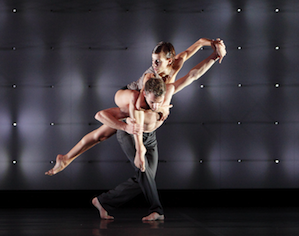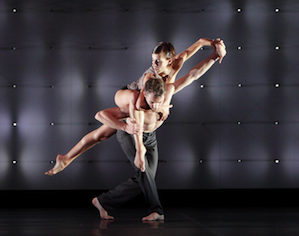
Photo by Ravi Deepres
Random Dance, the London-based company founded in 1992 by the multifaceted, multitalented Wayne McGregor — resident choreographer of the Royal Ballet, with Random Dance the resident company at Sadler’s Wells — delivered a brief, yet stunning, thoroughly satisfying show Sunday at the Lam Research Theater in San Francisco.
Far, which McGregor, in collaboration with his dancers, choreographed in 2010, lasts but an hour, but what an hour it is. The bios of the 10 dancers (five women, five men), an international assortment, show strong backgrounds in ballet as well as modern (often, or so it would seem, random) dance, standing them in tremendous stead when they flash — as brightly and quickly as the twinkling lights of Lucy Carter’s design on Random International’s set — between adagio and allegro, angular and melting, domesticated and feral. Bodies are beautiful. Bodies are freely distorted; we see one man jittering his foot and a duo stepping forward, dislocating their hips and shoulders as they go, looking like funhouse reflections, or chimps. Just as quickly, beauty is reclaimed in a smooth, stunning leap, a long-held pose.
The narrative, sketchy though it is, traces compelling paths through the world of nature as well as humanity, and, not surprisingly from McGregor, science and technology as well as art. It’s a lot to pack into an hour, but he gets the job done. (More examples of McGregor’s range are on view at San Francisco Ballet, where McGregor’s Borderlands premiered last year.)
The dancers, all of whom were assigned problems to solve for the work — dancing gloriously not being enough — must be credited by name: Catarina Carvalho, Travis Clausen-Knight, Alvaro Dule, Michael-John Harper, Louis McMiller, Daniela Neugebauer, Anna Nowak, James Pett, Fukiko Takase, and Jessica Wright.
Bodies are beautiful. Bodies are freely distorted. … Just as quickly, beauty is reclaimed in a smooth, stunning leap, a long-held pose.
Far is an acronym for a Flesh in the Age of Reason, by Roy Porter, described in the program notes as a “history of 18th Century explorations into body and soul.” These explorations during the Enlightenment, McGregor said, are analogous to artists’ stripping away of layers to reveal and understand the creative process. That we do glimpse the process while reveling in the movements — the nuzzling embraces, combative swipes, airborne beats, shape-shifting from contemporary to balletic — makes it even more compelling as dance and as theater.
Far is also decorously hot. The dancers are all of a similar, though not identical, body type: long, lean, and leggy. Moritz Junge’s neutral-colored costumes — assorted briefs, athletic shorts and tights below, various shirts above — always reveal those wonderful legs, which are always busy doing intriguing, innately sexy things as part of couples, trios, ensembles. Seeing a male dancer in trousers toward the end of the piece was a real shocker. The tops were casual, but at times seemed to comport with the dancers’ moves; a woman’s one-shoulder, Grecian-style top made her seem like a moving statue.
Musically, Far is a wandering, seemingly impulsive puzzle, but not an off-putting one.
Lucy Carter’s lighting was spectacular. It began with four women holding torches, flanking dancers in the dark; gradually, as the dancing spread and unfolded, the torches were extinguished. Soon, against a white backdrop, specks of light flashed or fluttered, sometimes seeming like a swarm of butterflies, birds, or bees. At other times, the sense was celestial, from random stars to a bright north star outshining all the others. And as the dance progressed, the lights arranged themselves in orderly rows before the backdrop became a numerical display; the numbers, perhaps, of a known meaning to the company, but otherwise contributing to the work’s sense of overall mystery.
Musically, Far is a wandering, seemingly impulsive puzzle, but not an off-putting one, annoying static aside — thankfully, that didn’t last long. Ben Frost did the original music, which included the sounds of strings and piano; the rest was collage that included bits of German song, and a set of lyrics, based on Roy Porter’s text. Most strikingly:
The dancing partner/ The dancing partner/ The body/ The inseparable/ dancing partner/ Of mind and soul

